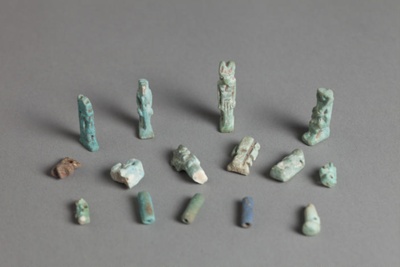< Collection search
< Collection highlights
From:UC Teece Museum of Classical Antiquities
Name/TitleGroup of Egyptian faience amulets
About this objectThis group of Egyptian faience amulets includes: Anubis; Isis with Horus; Isis with a stepped crown; Toth as an ibis; Amun Min; a Djed pillar; three beads and what is thought to be a Papyrus column.
In ancient Egypt, objects created using faience were considered magical, imbued with powers such as those of the sun and rebirth. The bright blue glaze was a colour that was closely linked with fertility, life, and the sun.
Beads were some of the earliest faience objects made in Egypt when it originated at the end of the fifth millennium B.C. Faience commonly take form as small figures of gods, animals and shabtis. It was used as jewellery, amulets, scarabs, and vessels, as well as, decoration for tombs and temples.
Place MadeEgypt
Medium and MaterialsCeramic: Faience
Style and IconographyEgyptian (ancient)
TechniqueMolding (forming)
TechniqueModeling (forming)
TechniqueGlazing (coating process)
MeasurementsLargest: 34 x 7 x 11mm
Subject and Association KeywordsAnimals in art
Subject and Association KeywordsArt and mythology
Subject and Association KeywordsArt and religion
Subject and Association KeywordsChildren in art
Subject and Association KeywordsGoddesses in art
Subject and Association KeywordsGods in art
Named CollectionThe James Logie Memorial Collection, University of Canterbury, New Zealand
Object TypeAmulets
Object number198.04
Copyright LicenceAll rights reserved
